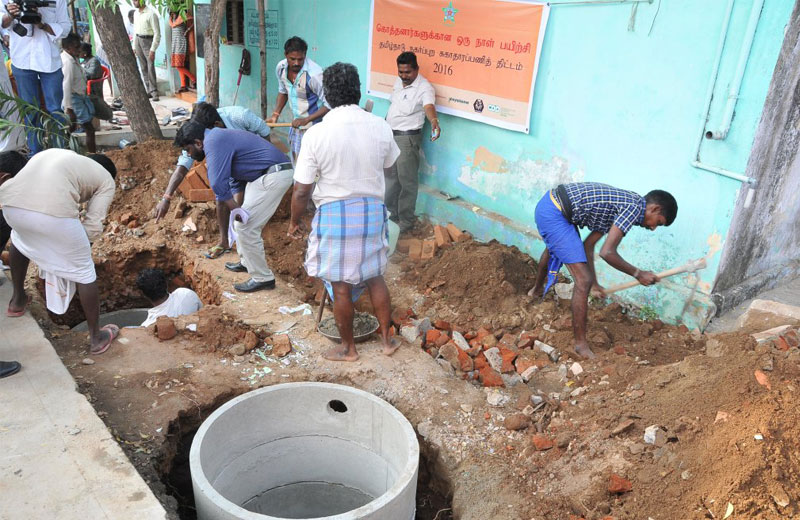Who built the Taj Mahal? Yes, that’s right. The masons built it.”
With this opening remark, the Masons’ Training Programme held at Coimbatore was kicked off.
I had the opportunity to join in on the Masons’ Training initiative conducted as a part of Capacity Building initiative in both Trichy and Coimbatore.
Now for a brief introduction to the training programme: the audience belonged to an age group ranging between those in their teens to those in their 60s. The average experience ranged from 20 to 30 years. About 35 attendees were present in each of the venues and the training programme was coordinated by IIHS, CDD and Gramalaya in Trichy and, IIHS, CDD and Keystone foundation in Coimbatore.
Why was a training programme needed for the masons? It has been found that in most households septic tanks are mere holding tanks built without any proper lining. And these are not desludged regularly which has led to groundwater contamination. The training programme was arranged to create awareness among the masons on the sanitation value chain and provide them with information on how to construct septic tanks and twin pits according to the Indian Standard Guidelines.
What did the masons learn? Though most masons seemed to know the dimensions of the septic tank to be constructed (for an average household of five people), particulars about twin pit construction and information about gas formation in septic tanks were new to them. The masons were also unaware of important details like the necessity and placement of vent pipes. This knowledge was imparted during the training.
What we can learn from the masons? There were masons with over 30 years of experience sitting very patiently listening to the training programme with great modesty and respect for the instructors. Many were brilliant organisers in addition to being builders. In Trichy we conducted a session where a septic tank and twin pit was actually built. The manner in which the masons cooperated with each other was notable. Most of them had no experience of working together yet they managed to divide the work amongst themselves efficiently and execute it. In another instance, during the Coimbatore training programme, the masons were given a task in which they had to make a bio-toilet model from hardboard cutouts. Bio-toilets are to be placed above the ground level with steps leading to the door. In the model that they were asked to build the door of the toilet opening outside. One of the masons pointed that if there are to be steps leading upwards to the door, the door has to open on the inside. The masons were aware of these small but important details in construction, which if ignored would lead to difficulties at a later date.
What I learnt from the training? Educated personnel, such as professional engineers, are ignorant of technical terms in native/regional languages, which are crucial in communicating with those on the ground especially if we are attempting to change their habits. I learned many of the commonly used engineering terms in the regional language during the training programme, including words for treatment, technology, advanced technology, septic tank, soak pit, twin pit, single pit etc. This was of considerable benefit and motivated me to find out the translations or the words used by masons in my native language as well.
Another lesson I learnt was one of wisdom that is acquired from experience. So for instance, it is one thing to know that if plastering is to be done, then the ratio of cement to sand is 1:6, (being a civil engineer I know this) then again the amount of water to be added is something I will require some time and effort to get right. But for the masons all of this comes naturally – without any effort at calculation. It is my belief that civil engineering students should spend at least a day with the masons to understand the difference between “textbook knowledge” and one gained through experience.
Was the mason’s training helpful to the masons? Though they were aware of the basics, many masons were deficient in their grasp of crucial details to be kept in mind during the construction of a septic tank or twin pit- regarding vent pipes, gas formation etc. Filling these gaps in their existing knowledge helped the masons a great deal. And when we see proper onsite sanitation systems being built in the households of Trichy and Coimbatore in the coming years, we will get a definitive answer on how useful the training was.

Vimala PP
Junior Specialist, TNUSSP


Leave A Comment
You must be logged in to post a comment.